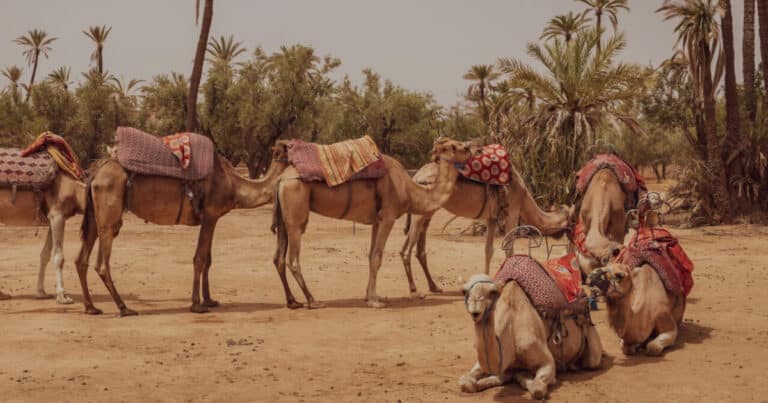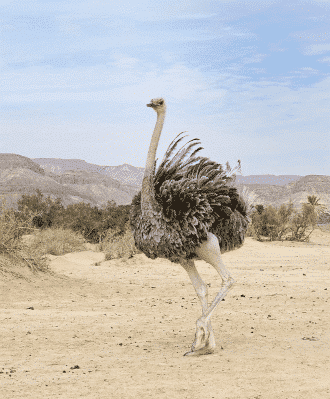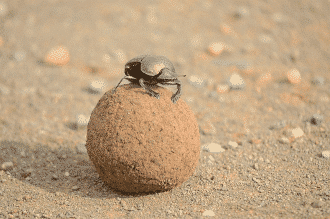By Alana House – Life on Earth has always thrived despite facing some of the hardest challenges that nature throws at it. Organisms that inhabit hot and dry deserts are no exception. Whether covered in fur, feathers or scales, desert animals are experts in navigating their sandy landscape.
The Sahara Desert
Located in North Africa, the Sahara is the largest hot desert in the world. About 8,600,000 square kilometers in size, this desert is extended across 11 countries in Northern Africa. The most distinct feature of the Sahara desert is its extremely harsh conditions, as daytime temperatures can reach to 120℉ (49℃) but nights have lows that drop below freezing.
A common misconception is that the Sahara desert is primarily composed of desert sand. In actuality, the Sahara contains mountains, oases, arid valleys, stone plateaus and even rivers!
Mammals
It is bizarre to think that both human beings and bunny rabbits are both classified as mammals because the differences between them are physically obvious. Indeed, while different mammals thrive in the Sahara desert their methods of survival are far from identical.
Small Mammals
Hiding from predators, using less resources and a greater range for locomotion are all biological advantages that many animals get from their small size. Numerous species of rodents can be found navigating the Sahara desert.
Gerbils are one of the smaller animals that survive the desert conditions by adapting to a nocturnal lifestyle, burrowing during the day to avoid the extreme heat. Another dexterous small animal is the Jerboa who burrows during the day like it’s rodent kin, but in the evening emerges to forage for grass seeds, succulent parts of desert plants and hardy insects.
Averaging at a body weight of 2.2 to 3.3 pounds and length of 9.5 to 16 inches is the fennec fox. Using their unusually large ears to radiate body heat, these tiny sly creatures have expertly adapted to outsmart the Sahara desert heat.
As one of the smallest canid species, the male fennec fox, like many canines, will mark their territory at the arrival of mating season, signifying to passing fennec foxes they are eligible mates or deadly competition. Similarly to the pale fox which also roams the Sahara desert, the fennec fox diet consists of insects, eggs, small animals, and any fruit they can find. As drinking water is scarce, much of animals’ hydration comes from ingestion of desert plants.
Larger Mammals
The Sahara desert is called home by many large grazing mammals who have over the years adapted to the deathly dry conditions of their habitat. The barbary sheep is a species of goat-antelope known as caprid and are found in the rock crevices of the Atlas mountains. Using shelter and shade during daylight hours, the barbary sheep keeps to grazing grass and bushes at dusk or dawn.
Prowling the North Western Sahara is the African cheetah, an elusive cat that leaves people with many questions about this desert predator. Comparable to other species of predatory mammals, the Saharan cheetah is an obligate carnivore.
Their diet consists of herd animals such as the Dorcas gazelle or the Addax antelope. The Saharan cheetah will also eat small animals like hares to sustain their dietary requirements.
Traveling the largest desert in the world is no simple feat for humankind. Human bodies are not well adapted to the extreme heats of the desert, and therefore must rely on creatures who are. One animal that has been assisting Arab groups with desert travel for centuries is the Dromedary camel.
A healthy adult camel can reach an average weight of 1,600 pounds and a height of over 7 feet tall at the hump. These humps are stored with fat that allows camels to travel distances of up to 100 miles through harsh desert terrain. Other adaptions include long eyelashes that protect their eyes from sand and large tough lips that allow them to nibble on thorny plants.
Birds
Classified as Aves, all birds are warm-blooded vertebrates who share the distinguishing and unique factor of having feathers. In many cases, similarities between bird species end here, but many birds have learned to adapt to the Sahara desert in significantly different ways.
Taking Flight
Avoiding hot desert sands is a lot easier when you have wings to glide above it. One of these high fliers include vultures, specifically the Lappet-faced vulture and the Egyptian vulture. As scavengers, vultures play an important part in the Saharan ecosystem by disposing of dead carcasses, lessening the chance of diseases spreading by means of animals remains.
Another desert dweller that roams the sky is the sandgrouse, a bird closely related to the common pigeon. Unlike its city bound kin, the sandgrouse’s feathers are laid densely as an impressive desert adaption.
Not only do these feathers allow for protection against extreme heat, they also act as sponges. Male sandgrouses will wade around in pools of water to store moisture in their feathers, which allows their young birds to drink water from the safety of their nest.
Running with wings
Not all birds are created equally, and while all may have feathers, some do not put those feathers to use. This is the case with the North African Ostrich.
A lack of flying ability does not make these giant birds any less impressive as they are able to sprint up to 43 mph and have an average life span of 30-40 years. These resident birds are a critically endangered species and many fear that it will follow in the steps of its cousin, the Arabian Ostrich, and face extinction if conservation efforts aren’t made quickly.
Reptiles
A popular way to characterize reptiles is by calling them ‘cold-blooded’. Scientifically, reptiles are ectotherms, meaning they use external sources of thermal heterogeneity to regulate internal temperatures. Access to the hot desert sun that is present in the Sahara, allows reptiles to thrive in these arid conditions.
The West African crocodile is one large reptile that has special adaptations, unlike other members of its species, that make it perfect for the Sahara desert. One example is these crocodiles will cool themselves by finding shelter in caves or burrows because water is not as prolific in their arid habitat.
The horned viper is one of the many venomous snakes that call the Sahara desert their home. In order to navigate the loose sand dunes of the desert, the horned viper adapted a way of movement known as ‘sidewinding’. This method of movement prevents this snake from having excessive contact with hot desert sand, so it is less likely to overheat.
Bugs
Hiding in dense bushes, unreachable crevices and under rocks, insects in the Sahara desert have made it impossible to calculate just how many bug species are present in the largest hot desert. According to the Invasive Species Compendium, 28 species of termites alone have been recorded from the Sahara, exposing just how vast the diversity of bug life is.
Unconventional Desert Helpers
A bug that has made its presence known in the Sahara desert is the scarab beetle, a tiny creature that makes an appearance throughout Egyptian history as a very meaningful symbol representing life. This bug’s fame does not end here, as it plays an essential role in the Sahara desert ecosystem, aiding in the decomposition of animal waste. Dung beetles, as they are comically called throughout the world, are notorious for rolling animal dung into a ball and then feasting on it when the need arises.
Endangered Species
Due to unbridled human presence, several species in the Sahara desert have become critically endangered. Habitat destruction and accelerated desertification has made the Sahara desert uninhabitable by animals that had previously called this desert their home.
Effects Of Overhunting
For centuries, humans were able to live in an ecological balance with animals in the great Sahara desert. With the invention of weapons, such as rifles, the ability to hunt animals in the open desert terrain has become far too easy, contributing to species endangerment in the wild.
The Addax antelope once ranged the Sahara desert in herds of up to 20. Since 2000, the Addax has been labeled as endangered, and the number of them surviving in the wild is estimated as less than 100. Other mammals sought by hunters such as the Scimitar Horned oryx is completely extinct in natural habitats and is sustained only through breeding in captivity.
When prey decreases due to overhunting, natural predators also suffer. The number of Wild Dogs in the Sahara desert has dwindled to only a handful, as their main food sources have been stolen by human activity. The African wild dog is also a victim of poaching itself as the illegal meat trade is common throughout Africa including within the Sahara desert.
Sahara Desert And Religion
The Tuareg are a fascinating nomadic people who live in the Saharan desert. An article on the Bradshaw Foundation describes this fascinating group. The men wear indigo veils but the women do not.
The women do, however, play an important role in family and tribal decisions. Their religion is a combination of pre-Islamic animism and Islam, which they adopted from the great Prophet El Maghili in the early 16th century. As far back as the 5th century BCE, there is a record of them in the works of the Greek historian Herodotus.
Their name, “Tuareg,” is an Arabic term for, “Abandoned by God.” Perhaps it’s better to refer to them as they call themselves, “Imohag,” meaning “free men.” It’s ironic to think of these people who make the desert their home and are called by others, “abandoned by God,” but think of themselves as “free men.”
This is a reminder not to judge others. After all, one man’s desert is another man’s home. Supporting indigenous people to thrive in their local environment is incumbent on the Western world, as climate change threatens Africa and other vulnerable areas. We must never abandon the indigenous peoples.
* Featured image source







